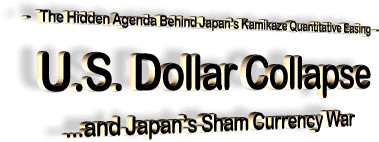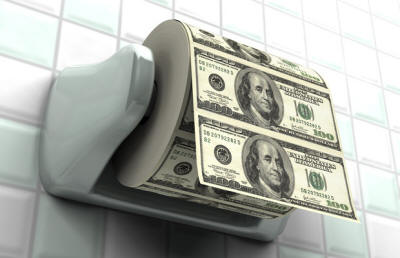-
The US is the world’s biggest debtor.
The biggest creditors are China and
Japan, followed by the oil exporting countries in the Middle East.
With each passing day, the value of the US$ toilet paper is worth
less and less. Like I said earlier, even toilet paper has some
intrinsic value.
It reaches zero value when everyone has
to carry a wheelbarrow of US$ to purchase anything.
-
For the US$ toilet paper creditors, they
cannot admit the fact that they have been conned by the global
Too Big To Fail Banks (TBTFs) acting in concert with
the FED and the Bank of England to
accept US$ toilet papers.
The central bankers of these countries
have a reputation to preserve (not that there is in fact any
reputation, for their so-called financial credibility is also part
of the scam) and the political leaders that relied on them is in a
bigger bind.
How can the political leaders be so very
stupid to trust these central bankers (who have stashed away in
foreign tax havens huge US$ toilet papers as a reward for their
complicity). This is the current state of affairs in plain English.
They are having sleepless nights
worrying if and when the citizens would wise up to this biggest con
in history i.e. the promotion and acceptance of fiat currencies, the
US$ being the ultimate fiat currency.
-
The
global financial elites led by the
FED know that this state of affairs is to their advantage and they
are exploiting it to the hilt!
They also know that no country or
organization has the military resources to threaten the US to stop
this global ponzi scheme which has been going on since 1945 and
intensified since 1971 when President Nixon de-coupled the US$ from
gold.
The pound sterling is another story but,
it is not relevant for the purposes of this analysis.
-
Additionally, and as a result of the
above-stated scam, countries were led to believe and to accept the
false economic theory that export generated growth (GDP) should be
the foundation of economic development, as the United States having
limitless US$ toilet paper has the ability and the means to purchase
the global exports, it being the largest consumer market in the
world.
In the result, the world’s factories and
their workers, including those in the developed world such as France
and Germany worked their butts off to be rewarded with US$ toilet
paper whose value is less than the paper and ink that produce it!
The financial frolic went on for more
than forty years and came to an abrupt and foreseeable end in the
2008 global financial tsunami.
-
When the party ended, the United States
was up to her eyeballs in debts as a result of reckless financial
speculation in the global derivatives casino and the consumption
binge financed by housing mortgages.
Debts must be repaid. But, the US has no
means to do so. They cannot produce enough goods to earn the revenue
to pay the debts because US manufacturing has been outsourced to the
developing world - China became the world’s number 1 factory.
So, the financial elite appointed
helicopter Bernanke to lead the charge for the US and the UK to use
the printing press (digital or otherwise) to print more US$ toilet
papers to pay off the debt.
In economic jargon, this is “monetizing
the debt”.
It is outright fraud, but no one (i.e.
central bankers) in his right mind would admit to this fraud as they
would be hung from the lamp-posts if the truth is discovered as was
the case when the Italian fascist leader Mussolini was hung by the
Italian partisans.
-
Initially, central bankers confronted
with this situation and having to face a restless populace embarked
on a regime of competitive easing/devaluation of their currencies.
But, the price was horrendous. Inflation
spiked in all these countries. But, this scheme of things did not
work out as planned for the simple reason, the US$ toilet paper
continued to be lower as a result of more QE by Bernanke.
China realized the danger and adopted
other means to overcome this situation, one of which was to enter
into bilateral arrangements with her trading partners to finance
trade in their respective currencies. Such agreements were entered
between China and Japan, members of BRIC, Malaysia etc.
This counter-measure was perceived as a
threat to the continued dominance of the US$ toilet paper regime.
In the result, Obama declared at the
urging of the financial elites (he does not have the grey cells to
think) a foreign policy shift - the Asia Pivot to prevent a further
deterioration of US$ dominance.
-
When Japan entered the agreement with
China, her behavior was deemed unacceptable since Japan was under
the nuclear protection of the US.
Japan was caught between a rock and a
hard place. It was expected that sooner or later the US would apply
the squeeze on Japan to behave in a proper manner.
Applying geopolitical strategies, the US
towing South Korea along provoked North Korea by launching a
military exercise which included flying B-2 bombers which are
capable of carrying nuclear weapons. North Korea responded in the
manner that was expected.
Japan was exposed and in like manner
reacted by seeking US protection. To muddy the waters and complicate
the situation, the US engineered a dispute between China and Japan
over the sovereignty of the
Diaoyu Islands.
This was followed by the installation of
a new regime in Japan by the election of the Prime Minister Shinzo
Abe and the appointment of Haruhiko Kuroda as the Governor of the
Bank of Japan (BOJ).
-
Now comes the mechanics of US
counter-measures in shoring up the artificial dominance/value of the
US$ toilet paper.
Japan was ordered to do its part as a
quid pro quo for being protected by the US’s nuclear umbrella. A new
version of
the Plaza Accord must be put in
place - a “reverse Plaza Accord”.
-
Let me explain. In the 1985 Plaza
Accord, the dollar was devalued to reduce the current account
deficit and to help the US recover from the recession of the early
1980s.
It was a managed devaluation and the
exchange value of the Dollar versus the Yen declined by 51 per cent
from 1985 to 1987 - reaching ¥151 per US$1 in March 1987. The dollar
continued to slide till 1988.
The effect of the strengthened Yen
depressed Japan’s exports and brought about the expansionary
monetary policies that resulted in the infamous asset bubbles of the
late 1980s. The G-6 countries then gathered in 1987 in Paris to
arrest the slide of the dollar and to manage and stabilize the
international currency markets. The end result was the Louvre
Accord.
In the next 18 months the dollar
strengthened to ¥160 per US$1.
-
However, in the current situation, the
devaluation of the US$ toilet paper was the result of
massive QEs so as to enable US to
monetize her debts.
However, for US to continue to monetize
her debts and have the world’s central banks agreement to continue
to hold dollar reserves, the value of the dollar must appreciate,
failing which the dollar would collapse, the US defaulting on her
debts, as creditors would no longer accept US$ as payment.
The trick was to artificially inflate
the value of the dollar without arousing any suspicions.
-
In the 1970s, following the de-coupling
of the dollar from gold by President Nixon, the dollar would have
collapsed in like manner as it was not backed by gold. It became
pure fiat money!
The trick then was to create an
artificial demand for dollar which would in turn raise the value of
the currency. This was effected by the proposal of
Kissinger to the Arabs that if they
would dollarize their oil exports, the US would guarantee their
safety and survival even from the threats of Israel.
When the Arabs agreed to this
arrangement, every country in the world had to buy oil in US$.
Countries have to exchange their currencies into US$ to buy oil.
This demand for US$ strengthened the
currency and prolonged the US fiat money monopoly.
-
However, this option is no longer
available presently as oil is now being sold in other currencies
besides the US$.
The petro-dollar is no longer in
dominance. In any event, the continued use of petro-dollars would
spike the oil price and this would be inflationary and detrimental
to the US economy as well as the world’s economy in the present
economic climate - i.e. deep recession.
Another means must be used.
-
This is the reason for the sudden “shock
and awe” monetary policy of the new Japanese regime of Shinzo Abe
and Haruhiko Kuroda.
My detractors will accuse me of
indulging in conspiracy theories. But, the facts speak for
themselves.
I had said earlier, that the G-7
countries have collectively attempted to devalue their currencies
but, it did not stem the slide of the US$ because Bernanke was
increasing the intensity of QE since 2008.
And the EU was not willing and or able
to adopt a suicide policy of massive QE as Germany was well aware of
such a risk having suffered the negative effects of hyperinflation.
China would not
kow-tow to the US and in fact
together with fellow members of BRIC was adopting counter-measures
to confront Bernanke’s QE financial weapon.
That left only one country who can be
compelled to do the US bidding, to commit Hara-kiri to save and or
prolong the US$ toilet paper regime - Japan!
-
And so, Japan launched its sudden
massive QE and the desired effect is that now the US$ toilet paper
has artificially appreciated in value vis-a-vis the Yen and less so
with other currencies.
This cannot be disputed by my detractors
because:
-
On May 11, the financial elites
of G-7 countries explicitly agreed with this kamikaze policy
of Japan.
-
Koichi Hamada has also declared
earlier that the target for this policy is to allow the
dollar to rise to ¥110 per US$1 and this rise would be
managed in a staggered fashion in small increments (step by
step approach) thereby controlling the rate of inflation in
Japan which would not be allowed to exceed the agreed target
rate.
-
It is suggested that Japan can
do this because it can utilize its huge dollar reserves of
US$1.2 Trillion to manage the devaluation! According to Alan
Ruskin, the global head of Group of 10 foreign-exchange
strategy in New York at Deutsche Bank ASG, he said “I think
we are opening up the door to look at 105 in the next few
months and 110 by the end of the year…” and this surely must
be interpreted to mean that Koichi Hamada’s strategy is
definitely in play.

